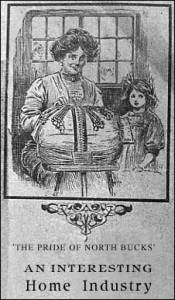Lace Making
Lace-making (Bucks Lace)
By Frankie Fisher
Lace-making was a cottage industry carried out by women, mainly as a supplement to the family income, although for some women it was their sole source of income.
As it required more skill than straw-plaiting, it was generally carried out by older women. The centre for the local industry was at Newport Pagnell, and finished products would be sold in the markets there.
Buckinghamshire’s lace makers were so famous that William Shakespeare wrote in Twelfth Night:-
“Spinsters and knitters in the sun and the free maids weave their threads with bone.”

A Swanbourne lace maker, circa 1900 (possibly Ann Alderman) from a watercolour painted in Swanbourne by miss Jane Myres.
According to the 1851 census, there were 38 lace makers in the village, together with one lace dealer.
In 1861, this there were still 38 women giving this as their occupation, though 6 of these, all aged 66 and over, described themselves as ‘former lace makers’. Aylesbury Road was named Petticoat Lane in Victorian times, and the ladies that lived in the cottages that stood there were lacemakers. As a site for making the lace edging around petticoats the occupation could have provided the name to the road. There is, however, an alternative explanation. The name could be derived from Norman French, as a corruption of ‘Little Cottage’, which would tie in with the earlier spelling of Petticote rather than Petticoat.
The numbers had dropped to 11 in 1871, 9 in 1881, and only 1 in 1891, a single woman aged 70. This last well known lace maker was Sarah Bowler, who died in 1898. However, there was another less well known lace maker named in the 1901 and 1911 censuses, Ann Alderman, who was a widow aged 49 in 1901.
It seems that by 1891, lace-making had become a very minor activity, limited to those who had no other means of support. The industry was larger and survived for longer (until 1921) two miles from Swanbourne, in neighbouring Winslow.
Further information on lace-making can be found at:
http://www.artworks-mk.co.uk/wp-content/uploads/2010/03/Lace-Making-Information-Sheet.pdf
Lacemaking was not a healthy job. The Lacemakers would usually be pale skinned from working indoors most of the time and also often had a stoop.
RETURN to Activities and Occupations Category
This post has 3 Simple Fields-fields attached. Show fields.


